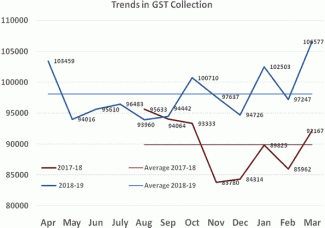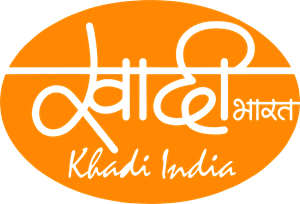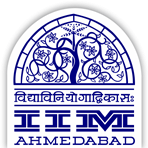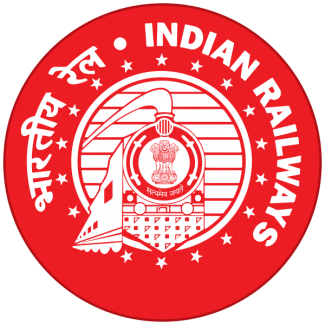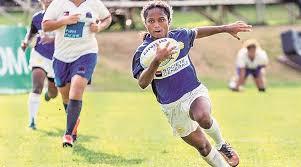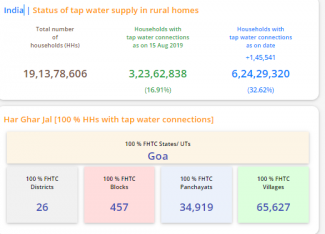
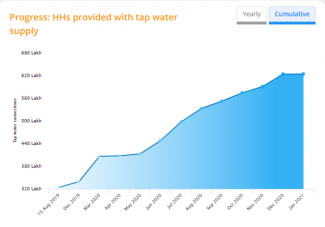
इस समाचार को हिन्दी में पढ़े आगे...
On 15th August, 2019, Jal Jeevan Mission was announced by the Prime Minister from the ramparts of the Red Fort with an aim to provide Functional Household Tap Connection (FHTC)to every rural household by 2024. Jal Jeevan Mission is under implementation since August, 2019 in partnership with the State governments with an aim to provide potable water in adequate quantity and of prescribed quality on regular and long-term basis. As on 15th August 2019, out of 18.93 Crore rural households, 3.23 Crore (17%) had tap water connections.
During this year, every State/ UT did extensive planning following ‘bottom-up approach’ and have firmed up their plan to provide tap water connection to every home. The untiring efforts of States/ UTs have helped Jal Jeevan Mission provide 3 Crore tap water connections since August, 2019. Further, 26 districts, 457 Blocks, 34,919 Panchayats and 65,627 villages have become 'Har Ghar Jal' meaning every family living in these rural areas is getting assured tap water supply in their homes and 'no one is left behind'. Goa has become the first State in the country to provide 100% FHTCs and became 'Har Ghar Jal' State. Different States are competing with each other and focusing on the set target to ensure that every household in the country gets safe drinking wateradhering to the core principle of 'equity & inclusiveness'.
States are giving priority to water quality-affected areas, Scheduled Caste/ Scheduled Tribe majority villages, aspirational districts, village in drought prone and desert areas and quality-affected habitations. States are working to ensure that piped water supply reaches the regions affected by Fluoride and Arsenic at the earliest as well.
The Jal Jeevan Mission journey so far has been filled with challenges and disruptions as the entire world battled with CoVid-19 pandemic from March, 2020 till date. All the works have been badly affected due to lockdown and construction work was badly affected in most parts of the country. Handwashing has become the most important tool meaning availability of adequate safe & clean water inside home has become all the more important. Giving primacy to this and with the spirit of changing lives, States/ UTs continued the water supply work following due precautions emphasized by the Government. Continuing work despite CoVid-19 also proved to be a boon for local economy generating livelihoods in their own villages, especially for the migrant labour who returned home.
As the Union government has been working towards making lives better for women across various sections by constructing individual household and community toilets, providing cooking gas, etc. similarly, tap water connections within the household aims to reduce drudgery and enhance 'ease of living' for young girls and women who are often burdened with the task of fetching water from the public stand post and walking long distances in search of water. By providing water at the doorstep, Jal Jeevan Mission is impacting the lives in multiple ways by improving the health parameters and reducing dropout from school among children.
Ensuring disease free life and holistic development of our children is a priority. In this spirit, a '100-Day Campaign' was launched on 2nd October, 2020 to provide piped water supply to every school, anganwadi centre (AWC) and ashramshala, i.e. residential schools for children from tribal communities. Under this campaign, potable tap water will not only be available for drinking and cooking mid-day meals, but also for hand washing and running tap water in toilets. So far, in 3 months, more than 4.4 lakh rural schools and about 3.73 lakh AWCs have started getting potable tap water. Punjab and Tamil Nadu have become the first States to provide every school with tap water supply. Also, every AWC in Tamil Nadu is provided with tap water.
Consumption of contaminated water has adverse impact on our health, especially children. In this backdrop, upgradation of water quality testing laboratories and its accreditation from NABL have been taken up. There are about 2,300 water quality testing laboratories with States/ UTs and these have been opened up to general public, so that they can get their water samples tested at a nominal cost. Also, emphasis is given to empowering local village community to keep surveillance on quality of water supply and/ or source through regular testing using Field Test Kits (FTKs). A grand challenge is going on in partnership with the DPIIT to develop ‘portable domestic water quality testing devices’.
Under Jal Jeevan Mission, Village Action Plans (VAPs) for five years, co-terminus with the 15th Finance Commission are prepared so that fund available to PRIs can be gainfully utilized by GPs for assured water supply delivery to homes. These VAPs are aggregated at district level to formulate the District Action Plans (DAPs), which are consolidated at State level to formulate the State Action Plan (SAP). SAPcovers projects like regional water supply schemes, bulk water supply and distribution projects, etc. to ensure drinking water security in the State.
The mission requires skilled human resources in areas like masonry, plumbing, fitting, electricals, pump mechanics, etc., in every village/ habitation, whose services will be used for creation of water supply schemes as well as regular O&M. Such a pool of skilled human resources in rural areas will make villages a self-reliant unit for regular upkeep and maintenance of water supply systems in line with idea ‘AtmaNirbhar Bharat’. This programme is to provide employment opportunities and boost local economy.
National Jal Jeevan Mission is assisting States/ UTs, which also include teams visiting villages to review the implementation and provide technical assistance to expedite the implementation with focus on prudent investment. The teams interact with members of GPs/ VWSCs and local community as well as PHED officials with focus on community participation and institutional arrangements for expeditious implementation. It is observed that local village communities, NGOs, SHGs, sector partners have joined hands to make Jal Jeevan Mission truly a ‘people’s programme’. The Mission is working on bringing about social and behavior change to ensure drinking water security.
पिछले एक साल में, जल जीवन मिशन के तहत 3 करोड़ से अधिक नल जल कनेक्शन प्रदान किए गए
15 अगस्त 2019 को प्रधानमंत्री नरेन्द्र मोदी ने लाल किले की प्राचीर से जल जीवन मिशन की घोषणा की थी जिसका उद्देश्य 2024 तक प्रत्येक ग्रामीण परिवार को कार्यात्मक घरेलू नल जल कनेक्शन (एफएचटीसी) प्रदान करना था। जल जीवन मिशन को राज्य सरकारों से साथ साझेदारी में अगस्त 2019 से लागू कर दिया गया था जिसका लक्ष्य नियमित और दीर्घकालिक आधार पर पर्याप्त मात्रा तथा निर्धारित गुणवत्ता में पीने योग्य पानी उपलब्ध कराना था। 15 अगस्त 2019 तक, 18.93 करोड़ ग्रामीण घरों में से 3.23 करोड़ (17 प्रतिशत) के पास नल जल कनेक्शन था।
इस साल (2020) के दौरान, सभी राज्यों/केंद्र शासित प्रदेशों ने सभी घरों को नल जल कनेक्शन प्रदान करने के लिए ‘बॉटम-अप अप्रोच’ का पालन करते हुए विस्तृत योजना बनाई और उस योजना को सुदृढ़ किया। राज्यों/केंद्र शासित प्रदेशों के अथक प्रयासों की मदद से जल जीवन मिशन ने अगस्त 2019 से अब तक 3 करोड़ नल जल कनेक्शन प्रदान किए हैं। इसके अतिरिक्त 26 जिले, 457 ब्लॉक, 34,919 पंचायत और 65,627 गांव ‘हर घर जल’ बन गए हैं अर्थात इन ग्रामीण क्षेत्रों में रहने वाले प्रत्येक परिवार के घरों में नल के जल की आपूर्ति सुनिश्चित की जा रही है और कोई पीछे छूटा नहीं है। गोवा 100 प्रतिशचत एफएचटीसी और हर घर जल वाला देश का पहला राज्य बन गया है। विभिन्न राज्य ‘समानता और समावेशन’ के मूल सिद्धांत का पालन करते हुए देश के सभी घरों में पीने योग्य सुरक्षित पानी की पहुंच सुनिश्चित करने के लिए आपस में प्रतिस्पर्धा कर रहे हैं और तय लक्ष्य पर फोकस कर रहे हैं।
राज्य की प्राथमिकता में जल गुणवत्ता प्रभावित इलाकों, अनुसूचित जाति/अनुसूचित जनजाति, अधिकांश गांव, आकांक्षी जिले, सूखे के संभावित गांव और रेगिस्तानी क्षेत्रों तथा गुणवत्ता प्रभावित स्थान हैं। राज्य फ्लोराइड और आर्सेनिक से प्रभावित क्षेत्रों में जल्द से जल्द पाइप वाले जल की आपूर्ति सुनिश्चित करने की दिशा में काम कर रहे हैं।
पूरी दुनिया मार्च 2020 से अब तक कोविड-19 महामारी से लड़ रही है और ऐसे में जल जीवन मिशन की अब तक की यात्रा भी चुनौतियों और बाधाओं से भरी रही है। देश के ज्यादातर हिस्सों में लॉकडाउन के कारण सभी कामों पर बुरा प्रभाव पड़ा है और निर्माण कार्य भी बुरी तरह प्रभावित हुआ है। चूंकि इस दौरान हाथ धोना कोरोना से लड़ने का सबसे प्रमुख साधन बन गया है, इसका मतलब है कि अब घरों में पर्याप्त रूप से सुरक्षित और स्वच्छ जल की उपलब्धता और भी अधिक महत्वपूर्ण हो गई है। इसे प्रमुखता देते हुए और जीवन में बदलाव की भावना के साथ, राज्य सरकारों/केद्र शासित प्रदेशों ने सरकार द्वारा बताई गई सावधानियों के पालन के साथ जलापूर्ति का काम जारी रखा। कोविड-19 के बावजूद नियमित रूप से हो रहे काम, उनके अपने गांव खासकर घर वापस लौटे प्रवासी मजदूरों के लिए आजीविका पैदा करके स्थानीय अर्थव्यवस्था के लिए वरदान साबित हुए हैं।
जिस प्रकार केंद्र सरकार खाना पकाने वाली गैस, सामुदायिक शौचालयों और व्यक्तिगत घरों के निर्माण सरीखे कार्यों द्वारा विभिन्न वर्गों की महिलाओं के जीवन को बेहतर बनाने की दिशा में कार्य कर रही है, उसी प्रकार घरों में नल जल कनेक्शन का उद्देश्य उन युवा लड़कियों और महिलाओं के कठिन परिश्रम को कम करना और ‘जीवन को सुगम’ बनाना है जिन पर पब्लिक स्टैंड पोस्ट से पानी लाने और पानी की तलाश में लंबी दूरी तक चलने का बोझ होता है। घरों तक पानी की उपलब्धता करवाकर जल जीवन मिशन जीवन स्वास्थ्य मापदंडों में सुधार करके और स्कूल जाने वाले बच्चों के ड्रॉपआउट की संख्या कम करके जीवन पर कई तरीकों से असर डाल रहा है।
बच्चों का समग्र विकास और रोग मुक्त जीवन सुनिश्चित करना इस मिशन की प्राथमिकता है। इस भावना के साथ, सभी स्कूलों, आंगनवाड़ी केंद्रों (एसीडब्ल्यू) और आश्रमशाला अर्थात आदिवासी समुदाय के बच्चों के लिए आवासीय विद्यालयों को पाइप वाले जल की आपूर्ति हेतु 2 अक्टूबर 2020 को ‘100-दिवसीय अभियान’ लॉन्च किया गया। इस अभियान के तहत, पीने योग्य पानी सिर्फ पीने और मध्यावधि भोजन पकाने के लिए ही उपलब्ध नहीं होगा, बल्कि हाथ धोने और शौचालयों में भी यह उपलब्ध होगा। 3 माह में अब तक, 4.4 लाख से भी अधिक ग्रामीण स्कूलों और लगभग 3.73 एडब्ल्यूसी को पीने योग्य पानी प्राप्त होने लगा है। पंजाब और तमिलनाडु सभी विद्यालयों को नल वाला जल उपलब्ध करवाने वाले पहले राज्य बन गए हैं। तमिलनाडु में इसके अलावा सभी एडब्ल्यूसी को भी नल वाला जल उपलब्ध करवाया जा रहा है।
दूषित जल का सेवन हमारे, विशेषकर बच्चों के स्वास्थ्य पर प्रतिकूल प्रभाव डालता है। इसे ध्यान में रखते हुए, जल गुणवत्ता परीक्षण लैबोरेट्रीज को अपग्रेड किया गया और एनएबीएल से इनकी मान्यता ली गई। राज्यों/केंद्र शासित प्रदेशों में लगभग 2300 जल गुणवत्ता परीक्षण लैबोरेट्रीज हैं और इन्हें सामान्यजन के लिए खोल दिया गया है ताकि वह मामूली दाम पर अपने पानी का सैम्पल परीक्षण करवा सकें। इसके साथ ही, स्थानीय ग्रामीण समुदाय को फील्ड टेस्ट किट (एफटीके) का प्रयोग करके जल की गुणवत्ता और/या उनके स्रोत की निगरानी करने के लिए सशक्त करने पर भी जोर दिया जा रहा है। एक बड़ी चुनौती डीपीआईआईटी के साथ साझेदारी में वहनीय घरेलू जल गुणवत्ता परीक्षण डिवाइस के विकास की भी है।
जल जीवन मिशन के तहत, 15वें वित्त आयोग से जोड़ते हुए पांच वर्ष के लिए ग्रामीण कार्य योजना (वीएपी) तैयार की गई है ताकि घरों में जलापूर्ति की सुनिश्चितता के लिए ग्राम पंचायत (जीपी) द्वारा पीआरआई के लिए उपलब्ध धन का लाभदायक उपयोग किया जा सके। इन वीएपी को जिला कार्य योजना (डीएपी) बनाने के लिए जिला स्तर पर एकत्रित किया जाता है जिसे फिर राज्य कार्य योजना (एसएपी) बनाने के लिए राज्य स्तर पर संगठित किया जाता है। एसएपी राज्य में पेयजल सुरक्षा सुनिश्चित करने के लिए क्षेत्रीय जलापूर्ति योजना, बल्क वाटर सप्लाई और वितरण परियोजना जैसे प्रोजेक्ट पर काम करती है।
मिशन को प्रत्येक गांव/रिहायशी क्षेत्र में चिनाई, प्लंबिंग, फिटिंग, इलैक्ट्रिकल्स, पम्प मकैनिक्स आदि क्षेत्रों में कुशल मानव संसाधन की आवश्यकता होती है, जिनकी सेवाओं का प्रयोग जलापूर्ति योजनाएं बनाने और नियमित संचालन व मरम्मत में किया जाएगा। ग्रामीण क्षेत्रों में इस प्रकार के कुशल मानव संसाधनों का समूह ‘आत्मनिर्भर भारत’ के विचार की तर्ज पर गांवों को जलापूर्ति प्रणाली के नियमित रखरखाव और मरम्मत के लिए आत्मनिर्भर बनाता है। यह कार्यक्रम रोजगार के अवसर पैदा करता है और स्थानीय अर्थव्यवस्था को बढ़ावा देता है।
राष्ट्रीय जल जीवन मिशन राज्यों/केंद्र शासित प्रदेशों की सहायता करता है, जिसमें कार्यक्रम के कार्यान्वन की समीक्षा हेतु गांवों का दौरा करने वाली टीमें और विवेकपूर्ण निवेश पर ध्यान देने के साथ कार्यक्रम में तेजी लाने के लिए तकनीकी सहायता उपलब्ध करवाना शामिल है। टीमें शीघ्र क्रियान्वन के लिए समुदायिक भागीदारी और संस्थागत प्रबंधन पर फोकस रखते हुए जन स्वास्थ्य अभियांत्रिकी विभाग (पीएचईडी), ग्राम पंचायतों (जीपी)/ग्रामीण जल एवं स्वच्छता समितियों (वीडब्ल्यूएससी) और स्थानीय समुदायों से बातचीत करती हैं। देखा गया है कि जल जीवन मिशन को वास्तव में ‘जन’ कार्यक्रम’ बनाने के लिए स्थानीय ग्रामीण समुदायों, एनजीओ, स्वयं सहायता समूहों और इस सेक्टर के अन्य साझीदारों ने हाथ मिलाया है। यह मिशन पेयजल सुरक्षा सुनिश्चित करने के लिए सामाजिक और व्यावहारिक बदलाव लाने के लिए कार्य कर रहा है।






